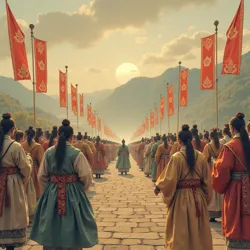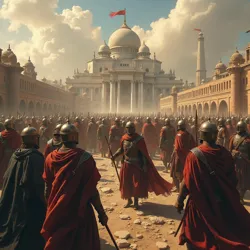Era of Fragmentation

Political division and independent kingdoms in the Jade Lands during the Era of Fragmentation, a period of disunion following the decline of central imperial authority.
Era of Fragmentation
Period of Disunion, Age of Independent Kingdoms
7th to 13th centuries CE
Jade Lands
dissolution of central imperial authority
Age of Contending States
The Era of Fragmentation (分裂時代, Fēnliè Shídài), also known as the Period of Disunion or the Age of Independent Kingdoms, designates a significant epoch in the history of the Jade Lands, spanning roughly from the 7th to the 13th centuries CE. This period is characterized by the protracted dissolution of central imperial authority and the emergence of numerous independent states across the region. Unlike periods of dynastic transition in other parts of the continent that typically culminated in reunification, the Era of Fragmentation in the Jade Lands solidified a pattern of enduring political division. This epoch is bookended by the decline of the Tang Dynasty (唐朝, Táng Cháo) and the eventual, though incomplete and resisted, attempts at unification under external forces in the later centuries. The Era of Fragmentation laid the groundwork for the subsequent Age of Contending States, further shaping the political and cultural mosaic of the Jade Lands.
Origins of the Division
The protracted fragmentation of the Jade Lands during this era was not a sudden event but rather the culmination of long-term trends and critical junctures that eroded the foundations of imperial unity. The seeds of division were sown during the later years of the Tang Dynasty, with a confluence of political, economic, and social factors gradually weakening the central government and empowering regional actors.
 The weakening of the Tang Dynasty and the Sokcheon Uprising contributing to the fragmentation of central authority and the rise of regional powers.
The weakening of the Tang Dynasty and the Sokcheon Uprising contributing to the fragmentation of central authority and the rise of regional powers.Decline of Central Authority
The Tang Dynasty, which had initially brought a period of relative stability and prosperity to the Jade Lands, began to experience internal strains and external pressures from the mid-7th century onwards. One of the most significant events contributing to the decline of central authority was the Sokcheon Uprising (朔天之亂, Shuòtiān zhī Luàn), a massive rebellion that, while eventually suppressed, critically weakened the Tang's administrative and military capacity. This uprising, named after the rebel leader General An Sokcheon (安朔天, Ān Shuòtiān), erupted in the northern frontier regions and rapidly spread to the heartland, necessitating a massive mobilization of imperial forces and the reliance on regional military governors (Jiedushi) to quell the revolt.
"The Heavens weep, the rivers run red, and the dragon throne trembles. Sokcheon's banners darken the sun, and the Emperor's armies are as scattered leaves in the autumn wind. Alas, the Mandate falters, and the realm is torn asunder."
— Lament of the Wounded Realm (傷域之哀歌, Shāng Yù zhī Āigē), anonymous poem from the late Tang period, reflecting the turmoil of the Sokcheon Uprising.
The Sokcheon Uprising, though quelled, exposed the fragility of the Tang's centralized military system. The dynasty became increasingly reliant on jiedushi for defense and internal security, granting these regional commanders significant autonomy in their territories. The cost of suppressing the rebellion also strained the imperial treasury, leading to increased taxation and economic hardship in many regions. This, in turn, fueled further discontent and weakened the legitimacy of the Tang court in the eyes of the populace.
Rise of Regional Powers (Jiedushi)
As the Tang Dynasty's central authority waned, the jiedushi gradually transformed from imperial officials into de facto regional warlords. Initially appointed to oversee military affairs in frontier zones, these governors amassed considerable military and administrative power within their jurisdictions. The weakening of central control allowed them to consolidate their personal armies, control local tax revenues, and appoint their own officials, effectively establishing mini-kingdoms within the Tang empire.
The jiedushi system, initially intended to strengthen border defenses, became a major centrifugal force. Many jiedushi positions became hereditary, passed down within families, further eroding central control. By the late Tang period, the imperial court in Chang'an was increasingly unable to effectively control or even influence the actions of these powerful regional governors. The relationship between the center and the periphery shifted from one of imperial command to a loose and often tense balance of power.
The rise of jiedushi was not solely a matter of political opportunism; it also reflected deeper socio-economic changes. The vastness of the Tang empire and the diversity of its regions made centralized administration increasingly challenging. Regional economies developed distinct characteristics, and local elites gained influence, often aligning themselves with powerful jiedushi who could protect their interests and provide regional stability. The jiedushi, in many cases, became the guarantors of local order and prosperity in a time of imperial decline.
Economic and Social Changes
Underlying the political fragmentation were significant economic and social transformations that further decentralized power and resources. The Tang economy, while initially vibrant, faced challenges in the later centuries. Population growth, land scarcity in fertile regions, and increased economic inequality contributed to social unrest and migration. The imperial government's capacity to manage large-scale economic projects, such as irrigation and infrastructure maintenance, diminished, impacting agricultural productivity and trade routes.
Regional economic specialization became more pronounced. The southern regions, particularly the Yangtze River delta and the coastal areas, experienced significant economic growth driven by maritime trade and agricultural innovations like rice cultivation. These regions, geographically distant from the Tang capital and benefiting from burgeoning trade networks, developed a degree of economic independence and were less reliant on the central government's patronage. Wealth accumulated in the hands of regional merchants and landowners, further shifting the economic balance of power away from the imperial center.
Socially, the late Tang period saw the rise of powerful local families and clans who exerted considerable influence in their regions. These landed gentry families often controlled vast estates, maintained private armies, and dominated local administration. They formed alliances with jiedushi, further strengthening regional power structures and weakening the social fabric of a unified empire. The traditional Confucian social order, which emphasized centralized imperial authority and social hierarchy, began to fray under the pressures of economic change and regionalism.
Characteristics of the Era
The Era of Fragmentation was a period of profound transformation, marked by political instability, economic dynamism, and cultural efflorescence. While warfare and political division were prominent features, this epoch was not simply a dark age of chaos. Instead, it was a complex and multifaceted era that laid the foundation for many enduring characteristics of the Jade Lands.
 Political instability, warfare between kingdoms, economic flourishing through trade, and cultural dynamism defining the Era of Fragmentation.
Political instability, warfare between kingdoms, economic flourishing through trade, and cultural dynamism defining the Era of Fragmentation.Political Fragmentation and Warfare
The most salient characteristic of the Era of Fragmentation was the absence of a unified imperial state and the prevalence of numerous independent kingdoms vying for power. The Ten Kingdoms Era proper, spanning roughly the late 9th to the mid-10th centuries, represents the apex of this fragmentation, with over a dozen major and minor kingdoms emerging from the ruins of the Tang Dynasty. These kingdoms, often ruled by former jiedushi or ambitious local strongmen, engaged in constant warfare, shifting alliances, and dynastic cycles of rise and fall.
The political landscape of the Jade Lands resembled a complex chessboard, with states constantly maneuvering for strategic advantage, territorial expansion, and economic dominance. Warfare was endemic, with conflicts ranging from large-scale campaigns involving tens of thousands of soldiers to localized skirmishes and border raids. Fortified cities, strategic passes, and riverine defenses became crucial elements of statecraft, as kingdoms sought to protect their territories and project power.
Despite the constant warfare, the political map of the Jade Lands was not entirely fluid. Certain states, due to geographical advantages, economic resources, or military prowess, managed to consolidate larger territories and achieve a degree of stability. Kingdoms like Liang-Ning in the north, Yong-An in the central plains, and Jing-Hua on the eastern coast emerged as major players, shaping the regional balance of power and setting the stage for the subsequent Age of Contending States. However, even these relatively powerful kingdoms were constantly challenged by rivals and internal instability.
Economic Flourishing and Trade
Paradoxically, the Era of Fragmentation witnessed significant economic development in many parts of the Jade Lands. While warfare disrupted trade routes and caused destruction in some areas, the fragmentation of political power also fostered economic competition and innovation. Independent kingdoms, seeking to strengthen their economies and attract talent, often adopted pragmatic policies to promote trade, agriculture, and craftsmanship.
Inter-state trade flourished despite the political divisions. Merchants from different kingdoms traversed the Jade Lands, exchanging goods and fostering economic integration at a regional level. The Liang River, Yong River, and Jing River served as vital arteries for commerce, connecting inland regions with coastal ports and facilitating the movement of goods. Maritime trade, particularly for the southern kingdoms of Minyue and Wuyue, expanded significantly, linking the Jade Lands to markets across Southeast Asia, the Indian Ocean, and even further west.
Technological innovation also contributed to economic growth. Advances in agriculture, such as improved irrigation techniques and new crop varieties, increased food production in some regions. Craftsmanship flourished in urban centers, with states competing to attract skilled artisans and produce high-quality goods for trade. The demand for luxury goods, such as silk, porcelain, and jade, stimulated production and innovation in various crafts industries. The economic dynamism of the Era of Fragmentation laid the foundation for the prosperity of later periods.
Cultural and Intellectual Dynamism
The Era of Fragmentation was also a period of remarkable cultural and intellectual creativity. The absence of a single imperial court and the rise of multiple centers of power fostered a vibrant cultural landscape, characterized by regional diversity and intellectual ferment. States vied for cultural prestige, patronizing arts, literature, and scholarship to enhance their legitimacy and attract talented individuals.
Regional cultures began to diverge more distinctly during this era. Each kingdom developed its own court culture, artistic styles, and literary traditions, reflecting local customs, historical experiences, and political ideologies. Liangningese culture, for example, developed a distinct martial character, influenced by its northern frontier location and its emphasis on military strength. Shuhanese culture, in the Sichuan basin, cultivated a reputation for artistic refinement, culinary innovation, and a more relaxed lifestyle. Yonganese culture, centered in the central plains, consciously sought to preserve and promote the cultural legacy of the Tang Dynasty, positioning itself as the heir to imperial traditions.
Intellectual life flourished amidst the political fragmentation. Scholars, artists, and religious thinkers moved between kingdoms, seeking patronage and disseminating new ideas. Different schools of thought emerged and competed for influence, contributing to a rich intellectual discourse. The Concordian Way, initially a philosophical movement, gained increasing prominence during this era, offering a framework for social harmony and spiritual guidance in a time of political turmoil. The cultural and intellectual dynamism of the Era of Fragmentation left a lasting legacy on the Jade Lands.
The Concordian Way and the Era of Division
The Era of Fragmentation was a formative period for the Concordian Way, contributing to its evolution from a philosophical current into a distinct religious and cultural tradition. The social and political conditions of the era, characterized by instability and a lack of central authority, created fertile ground for the spread and diversification of the Concordian Way.
 The Concordian Way rising in prominence during the Era of Fragmentation, offering social harmony and spiritual guidance amidst political division.
The Concordian Way rising in prominence during the Era of Fragmentation, offering social harmony and spiritual guidance amidst political division.Rise of the Concordian Way
The Concordian Way, with its emphasis on social harmony, Ancestral Veneration, and Moral Cultivation, resonated deeply with the anxieties and aspirations of people living through the Era of Fragmentation. In a time of political chaos and social upheaval, the Concordian Way offered a sense of stability, order, and meaning. Its core tenets of Harmonious Concord and the pursuit of balance appealed to a society yearning for peace and stability.
The decline of imperial Confucianism, which had been closely associated with the Tang Dynasty, created a spiritual vacuum that the Concordian Way increasingly filled. While Confucian values of social order and hierarchy still held sway, the Concordian Way offered a more adaptable and syncretic approach to spirituality, incorporating elements of Confucianism, Daoism, and local folk beliefs. Its emphasis on Ritual and Ceremony provided structure and communal cohesion in a fragmented society.
The absence of a strong central religious authority, akin to the imperial patronage of Buddhism during earlier dynasties, allowed the Concordian Way to develop organically and adapt to local conditions. Unlike more centralized religions, the Concordian Way did not face suppression or rigid state control during the Era of Fragmentation. This freedom allowed it to spread across different kingdoms, taking root in diverse social strata and regional cultures.
Religious and Cultural Impact
The Concordian Way exerted a profound influence on the cultural and social landscape of the Jade Lands during the Era of Fragmentation. Monasteries and temples dedicated to the Concordian Way became important centers of learning, community life, and social welfare. They provided education, offered refuge to the displaced, and mediated disputes, playing a crucial role in maintaining social order and providing spiritual guidance in a turbulent era.
The Concordian Way's emphasis on moral cultivation and personal ethics shaped individual behavior and social norms. Its teachings on benevolence, righteousness, propriety, wisdom, and trustworthiness (Moral Cultivation) provided a moral compass for individuals and communities navigating the complexities of a fragmented world. The concept of the Mandate of Heaven, adapted within the Concordian Way, provided a framework for understanding political legitimacy and the responsibilities of rulers, even in the absence of a unified empire.
Culturally, the Concordian Way permeated various aspects of life, from art and literature to music and ritual practices. Concordian themes of harmony, balance, and ancestral reverence found expression in artistic motifs, literary narratives, and musical compositions. Soul-Gardening, a contemplative practice emphasizing inner harmony and spiritual refinement, became a significant aspect of Concordian spirituality, influencing artistic and intellectual pursuits.
Mount Hua Holy See's Emergence
The Era of Fragmentation witnessed the gradual emergence of the Mount Hua Holy See as a central institution within the Concordian Way. Mount Hua, with its natural beauty and spiritual significance, had long been a site of religious practice. During the Era of Fragmentation, it gained prominence as a center of Concordian learning and pilgrimage.
Monasteries and temples on Mount Hua attracted prominent Concordian scholars and practitioners, who developed and disseminated core tenets of the tradition. The Temple of Celestial Balance (天衡 Temple, Tiān Héng Sì) on Mount Hua became the most important pilgrimage site, drawing followers from across the Jade Lands. The Harmonious Pontiff, residing at the Holy See, gradually emerged as the spiritual leader of the Concordian Way, although his authority was initially more moral and cultural than overtly political.
The Mount Hua Holy See benefited from the patronage of various kingdoms, who sought to enhance their legitimacy by associating themselves with the growing spiritual authority of the Concordian Way. Donations and endowments from rulers and wealthy individuals allowed the Holy See to accumulate land and resources, further consolidating its institutional power. By the end of the Era of Fragmentation, the Mount Hua Holy See had become a significant religious and cultural institution, laying the groundwork for its later role as a mediator between states and a promoter of pan-Jade Lands unity.
Legacy of the Era of Fragmentation
The Era of Fragmentation, despite its tumultuous nature, left a profound and enduring legacy on the Jade Lands. Its impact can be seen in the region's political landscape, cultural diversity, and the continuing influence of the Concordian Way.
Enduring Political Landscape
The most immediate and lasting legacy of the Era of Fragmentation was the solidification of a fragmented political landscape. While subsequent dynasties and periods of relative unity emerged, the Jade Lands never again experienced the kind of centralized imperial control that characterized earlier eras like the Tang Dynasty. The pattern of independent states, established during the Era of Fragmentation, persisted through the Age of Contending States and into the modern era.
The nine major states of the Jade Lands – Liang-Ning, Yong-An, Jing-Hua, Shu-Han, Min-Yue, Wu-Yue, Yan-Zhao, Qi-Lu, and Jin-Wei – can trace their origins, in many cases, to the kingdoms that emerged during the Era of Fragmentation. The political boundaries, regional identities, and inter-state dynamics established during this period continued to shape the political map of the Jade Lands for centuries to come. The enduring political division of the Jade Lands stands in stark contrast to the cyclical pattern of unification and fragmentation observed in other parts of the continent.
Cultural Divergence and Regional Identities
The Era of Fragmentation fostered a significant degree of cultural divergence across the Jade Lands, contributing to the rich tapestry of regional identities that characterize the region today. The distinct court cultures, artistic styles, literary traditions, and linguistic variations that emerged during this period solidified into enduring regional characteristics.
The Zhongyuan language family, encompassing languages like Liangningese language, Yonganese language, Jinghuanese language, and Shuhanese language, reflects the linguistic fragmentation that accelerated during the Era of Division. While sharing a common ancestral tongue, these languages diverged significantly in phonology, vocabulary, and grammar, mirroring the political and cultural separation of the Jade Lands. Regional cuisines, artistic styles, and social customs also diversified, further enriching the cultural mosaic of the region.
The cultural diversity of the Jade Lands, while sometimes a source of inter-state tension, also contributed to the region's intellectual and artistic vitality. The competition between regional cultures fostered innovation and creativity, resulting in a rich and multifaceted cultural heritage. The legacy of cultural divergence from the Era of Fragmentation remains a defining feature of the Jade Lands.
Foundation for the Age of Contending States
The Era of Fragmentation laid the groundwork for the subsequent Age of Contending States, a period of more stable, albeit still fragmented, political order. The major kingdoms that emerged during the Era of Fragmentation, such as Liang-Ning, Yong-An, Jing-Hua, and Shu-Han, consolidated their power and became the dominant players in the Age of Contending States.
The political and military strategies, diplomatic practices, and economic systems developed during the Era of Fragmentation shaped the dynamics of the Age of Contending States. The concept of inter-state diplomacy, the balance of power, and the importance of economic strength in statecraft all have roots in the experiences of the Era of Fragmentation. The enduring political divisions and regional rivalries of the Jade Lands, established during the Era of Fragmentation, continued to define the region's history in the centuries that followed. The Era of Fragmentation, therefore, represents a crucial turning point in the history of the Jade Lands, setting the stage for its unique and enduring political and cultural trajectory.